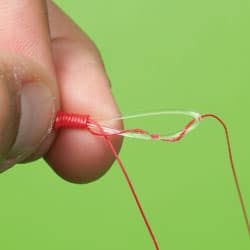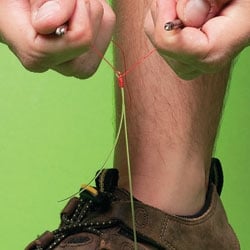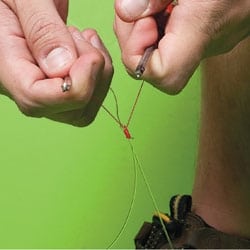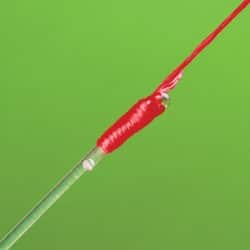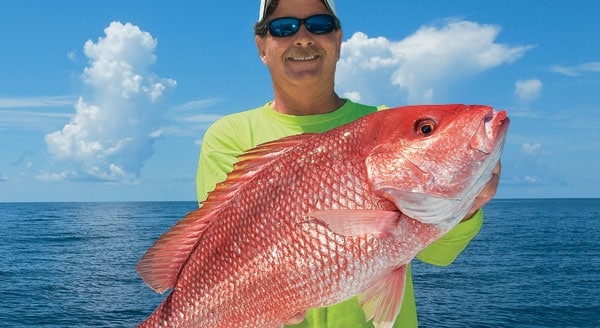
Purposely waking up at 3 a.m. is never a good idea. That is, unless you’re making a run to legendary bottom fishing grounds such as the Florida Middle Grounds in the Gulf of Mexico. The run is long, the water is deep — and the grouper, snapper and amberjack that swim out here are big, aggressive and mean. Leave your light tackle at home and load for bear. Capt. Mark Davis and Capt. Travis Palladeno are two bottom-fishing pros who shared some bottom fishing secrets to ensure that your next trip is well worth it.
Tackle for Bottom Fishing
When you are traveling this far for trophy fish, there’s no reason to stress over light tackle (unless you are pursuing a line-class record). Also, when you are dropping this deep, you want to make it count, because even reeling up a bare hook and sinker takes a lot of time and energy. Palladeno and Davis offer the following tips for selecting your tackle:
There are a lot of circle hooks on the market. For the best bottom fishing rigs, make sure to use one that describes a complete circle. A point positioned 90 degrees to the shank dramatically improves hookups.
Heavy-duty rods are a necessity. They need to be able to handle 100-pound braid without any problem and put a lot of heat on fish. For this type of fishing, keep your drag locked down at all times. You never want to give these fish an inch.
For this type of fishing, keep your drag locked down at all times. You never want to give these fish an inch.
Use heavy leaders on your saltwater bottom fishing rigs, as in 125-pound-test is the minimum. Make the fish make you go lighter. Also, check your leader before each drop to make sure it’s free from any abrasions and nicks. It’s a shame to drop all the way down, get a bite and lose the fish due to a sub-par leader. When using circle hooks, go two or three sizes larger than you would if you were using a J hook.
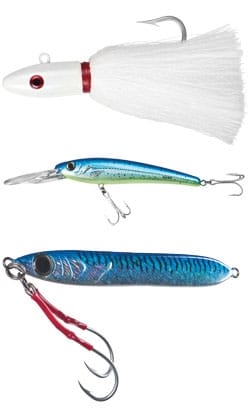
Bottom Fishing Lures
Davis knows that live baits are effective, but he feels that artificial lures offer several advantages.
His go-to jig for deep water is the 7-ounce Darter jig. “Darter jigs can be extremely effective, but you’ve got to experiment with them,” he says. “It’s best to fire one down and try several jigging actions until you figure out how the fish want it. Sometimes they want long, sharp jigs upward, and sometimes they are looking for short, erratic jigs. You just have to feel it out.”
Using any type of heavy jig is a great way bottom fishing technique to target specific species. For example, if you are pursuing snapper and amberjack, use your standard jigging tactics higher in the water column. But because of their shape, jigs sink fast enough to get past snappers, amberjacks and pesky bait-pickers if you are targeting groupers.
When a fish is hooked on a lure, the fight is immediately on, which gives you a better chance of keeping it out of structure. On live-bait rigs, your sinker is sitting on the bottom, and however long your leader is, that’s how many feet you are automatically giving the fish. It might not be much, but it’s often enough time for the fish to win and snag your bottom fishing rig.
When you are new to an area or just want to explore, trolling lipped plugs such as Bombers, between bottom-bouncing spots is a great way to prospect.
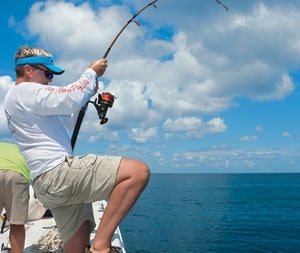
Bottom Fishing Techniques When You Get a Big Bite
- Keep your rod pointed straight down, and always make sure you are in contact with the bottom.
- Bring your rod straight up, get a turn or two on the reel and hold it there. Don’t give an inch.
- The fish will jolt a few times but almost always quit for just a second. That is your window of opportunity. In that window, get as much line on the reel as possible. Once you’ve pulled the fish 12 feet or so off the bottom, it’s pretty much game over for the fish. The point is to never allow the fish to take any line; if it does, make sure it earns it.
Best Live Baits for Bottom Fishing
No question, live baits are an extremely effective way to entice big bites from big fish. Here are some things to keep in mind when live-baiting for trophy bottom fish, such as using bottom fishing rigs for grouper.
“Inserting your hook in the bait’s lower jaw keeps it from spinning on the way down, which is very important when fishing in depths up to 600 feet,” says Davis. Palladeno adds that hooking your baits this way also allows them to breathe and keeps them vigorous. They both agree that if you are specifically targeting trophy bottom fish of any kind, the bigger the bait, the better.
Pinfish and blue runners are always a good bet, but any finfish swimming in the area is more than likely going to be what the big fish are keyed in on. If you can, get baits that are present in the area you’re fishing.
“Catch your baits on rod and reel whenever possible,” says Palladeno. “This puts the least amount of stress on the baits and will prolong their friskiness.”
Tying bottom fishing rigs, Palladeno and Davis prefer a long leader in order to protect the line from jagged rocks and structure. It also allows your baits to swim on a longer leash, which gives them a more natural appearance. When the bite is slow, Palladeno suggests using a dead Boston mackerel pinned to a heavy jig. Often the stink in the water will wake things up on the bottom.
How to Tie the Albright Special, A Great Knot for Bottom Fishing
Anglers often have problems connecting braid to their leader. A failed connection is not always due to slippage. Often the braid actually cuts through the mono. Multiple wraps spread out the pressure and prevent this. The Albright Special is a good knot choice for this connection, but it’s crucial to tie it carefully and correctly.
